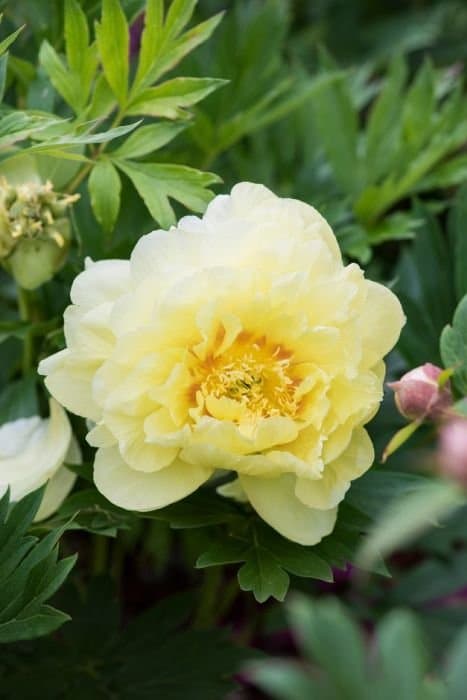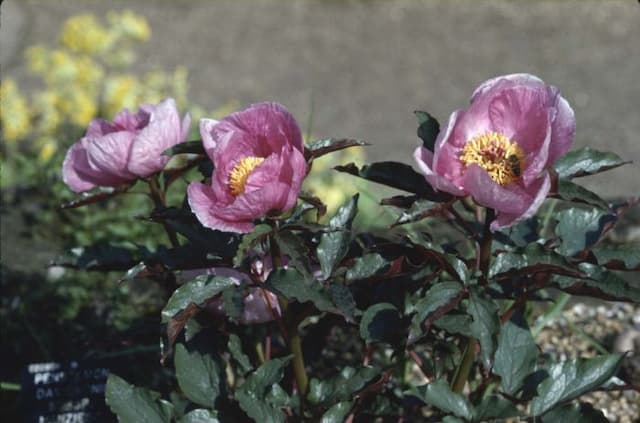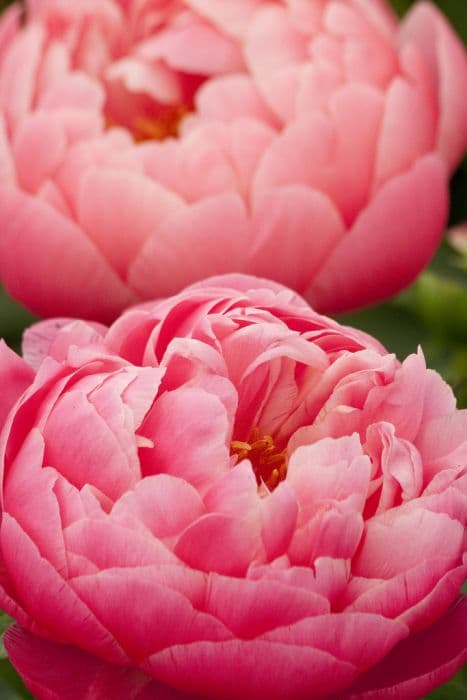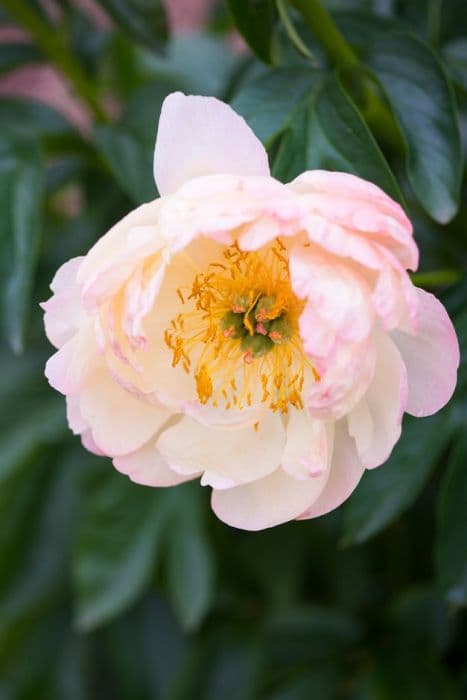Chinese peony Paeonia lactiflora 'Zi Feng Chao Yang'

ABOUT
The Paeonia lactiflora 'Zi Feng Chao Yang', commonly known as the Chinese peony, boasts an exquisite floral display with a lush, vibrant look. The plant features dark green foliage that provides a rich contrast against the striking flowers. These blooms are generally large and bowl-shaped, known for their layers of ruffled petals that create a full, round appearance. The petals can exhibit a gradient of color, often displaying a deep pink at the base that lightens to a soft pink or creamy white towards the edges. The centers of the flowers are typically adorned with a cluster of yellow stamens, which add a touch of brightness and attract pollinators. The Chinese peony emits a delightful fragrance, which makes it a favorite among gardeners looking to add both visual and olfactory appeal to their gardens. The plant starts off as a clump of green shoots emerging from the soil in early spring, which then develop into sturdy stems supporting the lavish blooms. After the flowering season, the plant remains visually appealing with its glossy green foliage, which continues to provide a rich backdrop in a garden setting until the leaves die back as winter approaches. The overall presentation of the Chinese peony is one of elegance and classic beauty, making it a sought-after ornamental plant for a wide range of garden styles.
About this plant
 Names
NamesFamily
Paeoniaceae
Synonyms
Chinese Peony, Common Garden Peony
Common names
Paeonia lactiflora 'Zi Feng Chao Yang'
 Toxicity
ToxicityTo humans
Peonies, including Paeonia lactiflora, are not considered highly toxic to humans. However, some people might experience an allergic reaction if they are sensitive to the plant. Ingesting parts of the peony plant can potentially lead to gastrointestinal upset, such as nausea, vomiting, or diarrhea. Handling the plant could also cause skin irritation in individuals with sensitive skin or peony allergies.
To pets
Peonies, including Paeonia lactiflora, are considered mildly toxic to pets, such as cats and dogs. If a pet ingests part of a peony plant, it may experience symptoms such as vomiting or diarrhea. These symptoms are indicative of gastrointestinal upset. It is recommended to keep peonies out of reach of pets and to contact a veterinarian if you suspect your pet has ingested this plant.
 Characteristics
CharacteristicsLife cycle
Perennials
Foliage type
Deciduous
Color of leaves
Green
Flower color
Pink
Height
2-3 feet (0.6-0.9 meters)
Spread
2-3 feet (0.6-0.9 meters)
Plant type
Herb
Hardiness zones
3-8
Native area
China
Benefits
 General Benefits
General Benefits- Aesthetic Appeal: Paeonia lactiflora, commonly known as Chinese peony, features large, showy flowers that add color and beauty to gardens.
- Landscaping Variety: It comes in different colors and forms, providing landscapers with a variety of options for garden design.
- Seasonal Interest: Chinese peony blossoms in late spring to early summer, offering seasonal interest in the garden.
- Attracts Pollinators: The flowers attract bees and other pollinating insects, which are beneficial for the garden ecosystem.
- Perennial Growth: As a perennial plant, it comes back every year, providing long-term value for gardeners.
- Cut Flowers: The blooms make excellent cut flowers for arrangements, with a long vase life.
- Cultural Significance: It has historical and cultural significance, particularly in China, where it is highly revered and often featured in art.
- Easy to Grow: Generally low-maintenance and easy to care for once established, making it suitable for gardeners of all skill levels.
- Cold Hardy: Capable of surviving in colder climates, which makes it a versatile choice for many gardens.
- Drought Tolerance: Once established, it can tolerate periods of drought, reducing the need for constant watering.
- Deer Resistance: Less attractive to deer, which can help to minimize damage to the garden from wildlife.
 Medical Properties
Medical Properties- Anti-inflammatory: Paeonia lactiflora may possess compounds that can help reduce inflammation.
- Analgesic: The root of Paeonia lactiflora, known as white peony, has been used in traditional medicine for its pain-relieving properties.
- Immunomodulatory: Some studies suggest that the peony may have an effect on the immune system, potentially modulating immune responses.
- Antispasmodic: Traditionally, Paeonia lactiflora has been used to relieve muscle spasms and cramps.
- Liver protectant: There is some evidence to suggest that compounds in Paeonia lactiflora may exercise a protective effect on the liver.
- Neuroprotective: Compounds found in Paeonia lactiflora might have the potential to protect nerve cells from damage.
- Cardiovascular effects: There has been some research into the cardiovascular effects of Paeonia lactiflora extracts, which may impact blood flow and heart health.
- Hormonal regulation: The root of Paeonia lactiflora has been used in traditional medicine to help regulate hormones, particularly in women's health contexts.
- Anti-oxidative: The peony may possess antioxidant properties, potentially fighting against oxidative stress and related conditions.
 Air-purifying Qualities
Air-purifying QualitiesThis plant is not specifically known for air purifying qualities.
 Other Uses
Other Uses- Paeonia lactiflora 'Zi Feng Chao Yang', commonly known as the Chinese peony, can be used in mixed flower arrangements. Its large, fragrant blooms add elegance and a splash of color to bouquets.
- The petals of the Chinese peony can be crystallized and used as edible decorations for cakes and desserts. This adds both aesthetic appeal and a mild floral flavor to culinary creations.
- The Chinese peony's strong stems can be used as natural supports for other plants in the garden. Smaller, less sturdy plants can be propped up against peony stems to prevent them from drooping.
- Dried peony petals can be used in homemade potpourris to impart a pleasant fragrance to rooms. They retain their scent for a considerable time after drying.
- The vibrant blooms of the Chinese peony can be floated in large decorative bowls of water to create simple, yet striking table centerpieces for events or home decor.
- The Chinese peony can be grown in large containers on patios and terraces as ornamental plants, providing both beauty and a subtle scent to outdoor living spaces.
- The leaves of the Chinese peony, with their rich green color and interesting shapes, can be used as a backdrop in floral photography to enhance the visual appeal of the subject flowers.
- When planted in a row, Chinese peonies can serve as an attractive, informal floral hedge. They can provide privacy and a seasonal display of color when in bloom.
- Pressed peony flowers can be used in craft projects, such as homemade greeting cards or bookmarks, adding a personalized touch with the beauty of real flowers.
- The Chinese peony can be incorporated into educational activities for children, such as gardening projects that teach about plant growth, care, and the life cycle of perennial plants.
Interesting Facts
 Feng Shui
Feng ShuiThe Peony is often used in Feng Shui to attract love and romance, as it is considered to represent wealth and honor. Place it in the southwest area of your garden or home to enhance relationships and invite matrimonial bliss.
 Zodiac Sign Compitability
Zodiac Sign CompitabilityThe Peony is not used in astrology practice.
 Plant Symbolism
Plant Symbolism- Romance and Prosperous Marriage: The Paeonia lactiflora, commonly known as the Chinese Peony, often symbolizes romance and is believed to bring good fortune to new marriages, reflecting the beauty and commitment of a loving relationship.
- Riches and Honor: In Chinese culture, the peony is associated with wealth, prosperity, and high social status, making it a common motif in art and celebrations.
- Feminine Beauty: The peony's lush, full blooms are likened to the ideal of female beauty in some cultures, embodying elegance and allure.
- Compassion: The delicate appearance of the flower can be interpreted as an expression of compassion and therefore sometimes associated with such tender emotions.
- Good Fortune: The Chinese Peony is considered a good omen, bringing good luck to those who receive or grow the flower.
 Water
WaterThe common name for Paeonia lactiflora 'Zi Feng Chao Yang' is Chinese Peony. Watering should be done deeply and infrequently to encourage deep root growth. Ideally, you should water the Chinese Peony once a week with about 1 inch of water, which is equivalent to roughly 0.6 gallons for a medium-sized plant. During the growing season, in spring and summer, you may need to water more frequently, especially if the weather is particularly dry or hot. It's crucial not to waterlog the soil, as peonies do not like standing water, which can lead to root rot.
 Light
LightThe Chinese Peony thrives in full sun to partial shade conditions. For optimal growth, plant your Chinese Peony where it can receive at least six hours of sunlight per day. While they can tolerate light afternoon shade, too much shade can inhibit blooming and weaken the plant.
 Temperature
TemperatureThe Chinese Peony prefers temperate conditions and can typically survive winter temperatures down to -20°F, with an ideal growing range between 65°F and 75°F during their blooming season. Summer heat above 80°F can cause the plant to go dormant, so in hotter climates, protection from the intense afternoon sun is beneficial.
 Pruning
PruningChinese Peonies require pruning to remove spent blooms and dead foliage, which helps prevent disease and encourages healthy growth. The best time to prune is after the blooms have faded, typically in late spring or early summer. Cut back the foliage to ground level in the fall after the first frost to prepare the plant for winter.
 Cleaning
CleaningAs needed
 Soil
SoilPeony 'Zi Feng Chao Yang' thrives in fertile, well-draining soil with a pH of 6.5 to 7.0. A mix composed of two-thirds garden soil and one-third compost or well-rotted manure is ideal. Incorporate perlite or sand for improved drainage.
 Repotting
RepottingPeonies like 'Zi Feng Chao Yang' seldom require repotting and can thrive in the same location for many years. It is generally only necessary to repot or divide them if the plant becomes overcrowded, about every 10-15 years.
 Humidity & Misting
Humidity & MistingPeony 'Zi Feng Chao Yang' is tolerant of a range of humidity levels and does not require specific humidity conditions to thrive, as long as it is planted in the ground and has adequate soil moisture.
 Suitable locations
Suitable locationsIndoor
Provide bright light, cool temperatures, and plant in well-draining soil.
Outdoor
Plant in sun or part-shade, fertile soil, and provide space for roots.
Hardiness zone
3-8 USDA
 Life cycle
Life cyclePaeonia lactiflora 'Zi Feng Chao Yang', commonly known as Chinese Peony, begins its life cycle as a dormant tuberous root during winter. In early spring, the root sprouts and produces shoots that develop into stems and leaves, and the plant enters a vegetative growth phase. By late spring to early summer, the plant flowers, showcasing large, fragrant blooms that attract pollinators. After pollination, the flowers fade and seed pods may form, which, when mature, release seeds. The plant then enters a period of senescence in late summer, where foliage begins to yellow and wither. With the arrival of autumn, the plant prepares for dormancy, retreating back to the root until the next growth cycle commences.
 Propogation
PropogationPropogation time
Spring
Paeonia lactiflora 'Zi Feng Chao Yang', commonly known as Chinese peony, can be propagated by division, which is the most popular method for this plant. The ideal time for dividing peony plants is in the fall, when the plants have become dormant. Division involves digging up the entire plant and carefully separating the root clumps into smaller sections, ensuring that each new section has at least three to five eyes, or growth buds. These sections should then be replanted immediately at the same soil depth they were previously, typically about 1.5 to 2 inches (3.8 to 5 centimeters), while ensuring sufficient space for future growth. Watering thoroughly after planting is crucial for helping the newly divided plants establish in their new location.









